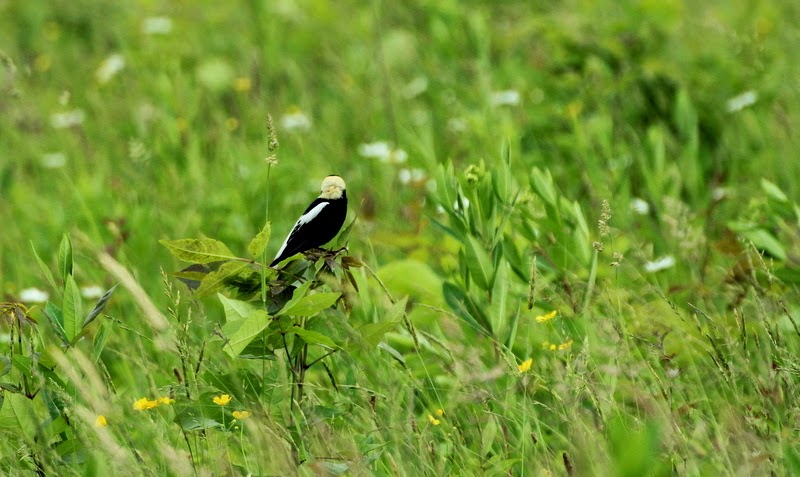The Bobolink road trip is heading east today. One of the reasons I became so intrigued by Bobolink songs at specific sites was because the Bobolinks at Holden Arboretum in Lake County have song components that are completely different from those in southwestern Geauga County. What’s going on with the songs in the eastern parts of NE Ohio?
There are scattered Bobolinks
in Geauga County, so I set out to find ones I hadn’t yet heard. I made two trips to Observatory Park in far
NE Geauga County and found a few Bobolinks singing in a meadow near the
observatory itself. I later came across two singing males in the northwestern
part of this large park. Their songs were
the same at both parcels, and these songs were different from others I’ve heard
to date.
Here’s what I heard when the
males were doing what I call their “fancy flight” – a slow, fluttering flight
display accompanied by a long and extremely complex song. Savannah Sparrows were singing from their perches as the Bobolinks circled above the meadow.
As you know by now, the next
step is to try to extract the recognizable song components from their songs, as
these are what will make each Bobolink group identifiable by ear. Recognizing song components in the flight
song is very difficult, but those recurring pitches are much more accessible in
the Bobolinks’ shorter songs. I’ll
include a sonogram for the first part of the recording so you can see what you’re hearing.
What next? Time to head 9 miles south to Swine CreekReservation, a beautiful Geauga Park District property outside of Middlefield in Amish country. Swine Creek has stunning woodlands, a gorgeous stream, and a characteristically NE Ohio goldenrod meadow. It's not the grassland meadow that Bobolinks generally prefer, but I'd read on eBird that Bobolinks had been reported there. Sure enough – there were two singing males and at least one female.
I had expected recording them
to be easier than many places because the
sound of horses and buggies is just not that obtrusive. The unexpected challenge for me was a long-idle
old gas well that had suddenly come back to life. There it was, squeaking and rumbling
away in annoyingly close proximity to the Bobolinks. It
wasn’t going to stop, either, so I’d just have to do what I could with whatever I could
get.
I’m glad I didn’t give up and
leave, because there was something interesting here. I heard a song component that sounded very close to the three-note pattern from Frohring Meadows and South Russell Village Park 18 miles to the west/southwest. The bouncy triplet pattern wasn’t present and the notes were more separated (or "choppy"),
but the pitches jumped out at me. Here’s
the song pattern followed by a complex song.
Next is a recording of three statements of that song pattern. Sometimes the first two pitches are repeated and it’s as many as six notes, while other times it's just three. These pitches are not as smoothly-connected as the South Russell song, but I'm sure you'll hear the similarity. I’ve made the comparison easier by adding three statements of the South Russell song pattern at the end of this recording.
Were these Bobolinks previously part of a larger group? What about the small number of Bobolinks at each of the Observatory Park areas – did they split off from a larger group as well? When there are just a few Bobolinks at a certain location, where did they come from? I certainly wish I knew.
Our final stop for today is Metzger Park, and
it’s a bit of a drive. Metzger Park is
44 miles south/southwest of Swine Creek Reservation in Louisville, which is
east of Canton in Stark County. (That’s Louis-ville,
as in Louis with an “s”, by the way.) This city-owned park now
delays mowing its large, grassy meadows until after the Bobolinks have
fledged and are ready to leave for South America.
I began hearing Bobolinks as soon as I approached the trails that run through their extensive meadows. Here they are with the ever-present Red-winged Blackbirds.
I began hearing Bobolinks as soon as I approached the trails that run through their extensive meadows. Here they are with the ever-present Red-winged Blackbirds.
Next, here are two basic song
patterns. One is rather odd, and I
haven’t heard it anywhere before. It sounds
slower and more deliberate somehow, and that may in part be due to the straight
eighth notes where songs at other locations often have combinations of eighth and sixteenth notes
or even triplets. The song patterns in the first half of this recording, though, may remind you of something you just heard. We'll listen closer in the next recording.
Now listen to Swine Creek, South Russeell and Metzger back to back. What do you notice?
They're quite similar, aren't they? But Metzger Park is a significant distance from Swine Creek and South Russell, while places that are much closer have Bobolinks singing very different songs. I really want to know why!
I’ll leave you with one more recording from Metzger Park while you look at the map. (Observatory is the northernmost of the three parks.) I like the Metzger Bobolink songs a lot. OK, I like all of them a lot, and I’m very much enjoying hearing and learning so many different songs!
My final post in the Bobolink series will add songs from Lorain
and Ashland Counties. I'll summarize with a comparison of what’s similar and whose songs seem unrelated to anything I've heard to date. I'll also include a map of all the
places where I’ve recorded Bobolinks in the past few years. Who knows what I'll learn next year?








Very Interesting.. and Great Music...
ReplyDeleteMJD
Mark J Demyan
President
Audubon Society of Greater Cleveland